Top Rankings
Dover Public School District ranks among the top 20% of public school district in New Jersey for:
Category
Attribute
Community Size
Largest student body (number of students) (Top 1%)
For the 2025 school year, there are 5 public schools serving 3,262 students in Dover Public School District. This district's average testing ranking is 3/10, which is in the bottom 50% of public schools in New Jersey.
Public Schools in Dover Public School District have an average math proficiency score of 23% (versus the New Jersey public school average of 36%), and reading proficiency score of 39% (versus the 49% statewide average).
Minority enrollment is 96% of the student body (majority Hispanic), which is more than the New Jersey public school average of 62% (majority Hispanic).
Overview
This School District
This State (NJ)
# Schools
5 Schools
2,573 Schools
# Students
3,262 Students
1,360,617 Students
# Teachers
268 Teachers
116,573 Teachers
Student : Teacher Ratio
12:1
12:1
District Rank
Dover Public School District, which is ranked within the bottom 50% of all 646 school districts in New Jersey (based off of combined math and reading proficiency testing data) for the 2021-2022 school year.
The school district's graduation rate of 78% has decreased from 88% over five school years.
Overall District Rank
#478 out of 650 school districts
(Bottom 50%)
(Bottom 50%)
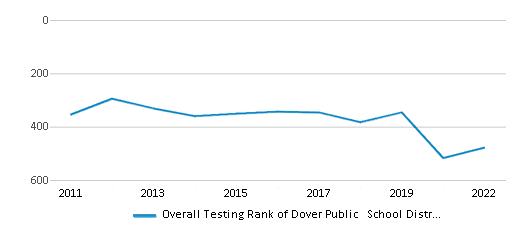
Math Test Scores (% Proficient)
23%
36%
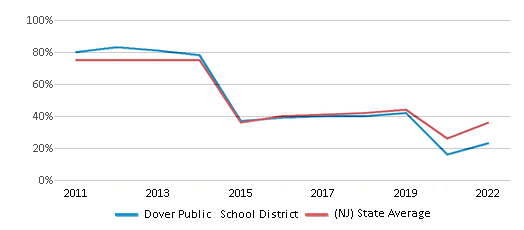
Reading/Language Arts Test Scores (% Proficient)
39%
49%

Science Test Scores (% Proficient)
14%
23%
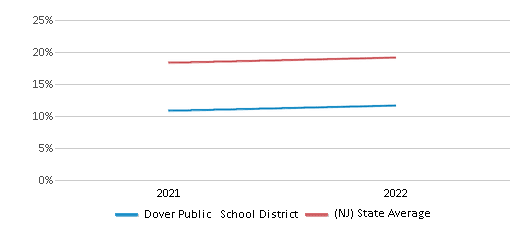
Graduation Rate
78%
85%
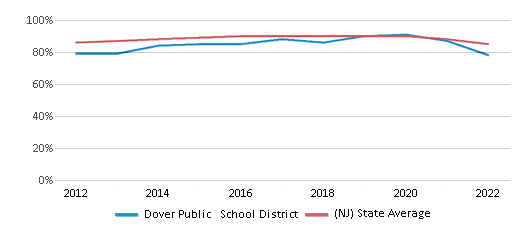
Students by Ethnicity:
Diversity Score
0.17
0.72
# American Indian Students
1 Student
2,837 Students
% American Indian Students
n/a
n/a
# Asian Students
40 Students
141,451 Students
% Asian Students
1%
10%
# Hispanic Students
2,963 Students
458,869 Students
% Hispanic Students
91%
34%
# Black Students
111 Students
195,970 Students
% Black Students
3%
15%
# White Students
128 Students
515,021 Students
% White Students
4%
38%
# Hawaiian Students
n/a
2,719 Students
% Hawaiian Students
n/a
n/a
# Two or more races Students
19 Students
42,985 Students
% of Two or more races Students
1%
3%
Students by Grade:
# Students in PK Grade:
64
61,597
# Students in K Grade:
201
91,086
# Students in 1st Grade:
212
93,943
# Students in 2nd Grade:
230
96,713
# Students in 3rd Grade:
227
95,865
# Students in 4th Grade:
229
97,373
# Students in 5th Grade:
219
98,202
# Students in 6th Grade:
221
99,575
# Students in 7th Grade:
227
100,830
# Students in 8th Grade:
256
101,895
# Students in 9th Grade:
315
107,031
# Students in 10th Grade:
274
106,285
# Students in 11th Grade:
332
106,937
# Students in 12th Grade:
255
103,061
# Ungraded Students:
-
224
District Revenue and Spending
The revenue/student of $21,903 in this school district is less than the state median of $26,931. The school district revenue/student has stayed relatively flat over four school years.
The school district's spending/student of $20,244 is less than the state median of $25,828. The school district spending/student has stayed relatively flat over four school years.
Total Revenue
$71 MM
$36,642 MM
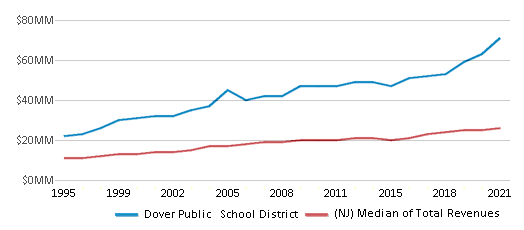
Spending
$66 MM
$35,142 MM
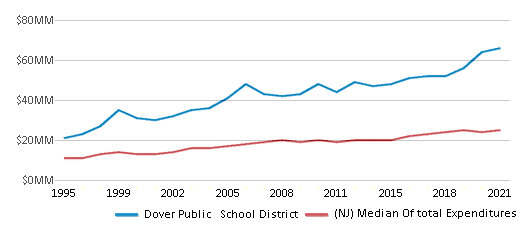
Revenue / Student
$21,903
$26,931
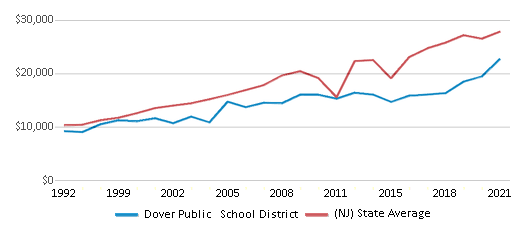
Spending / Student
$20,244
$25,828
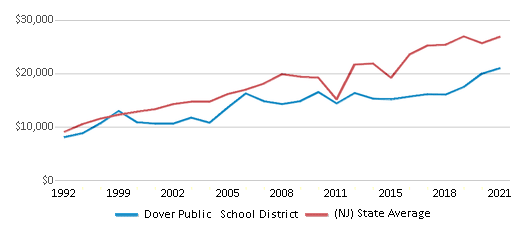
Best Dover Public School District Public Schools (2025)
School
(Math and Reading Proficiency)
(Math and Reading Proficiency)
Location
Grades
Students
Rank: #11.
Academy Street Elementary School
(Math: 25% | Reading: 41%)
Rank:
Rank:
4/
Bottom 50%10
14 Academy Street
Dover, NJ 07801
(973) 989-2030
Dover, NJ 07801
(973) 989-2030
Grades: PK-6
| 548 students
Rank: #22.
Dover Middle School
(Math: 24% | Reading: 41%)
Rank:
Rank:
4/
Bottom 50%10
302 East Mcfarlan Street
Dover, NJ 07801
(973) 989-2040
Dover, NJ 07801
(973) 989-2040
Grades: 7-8
| 483 students
Rank: #33.
Dover High School
(Math: 17% | Reading: 45%)
Rank:
Rank:
4/
Bottom 50%10
100 Grace Street
Dover, NJ 07801
(973) 989-2010
Dover, NJ 07801
(973) 989-2010
Grades: 9-12
| 1,176 students
Rank: #44.
East Dover Elementary School
(Math: 24% | Reading: 36%)
Rank:
Rank:
3/
Bottom 50%10
300 East Mcfarlan Street
Dover, NJ 07801
(973) 989-2055
Dover, NJ 07801
(973) 989-2055
Grades: PK-6
| 443 students
Rank: #55.
North Dover Elementary School
(Math: 23% | Reading: 33%)
Rank:
Rank:
3/
Bottom 50%10
51 Highland Avenue
Dover, NJ 07801
(973) 989-2020
Dover, NJ 07801
(973) 989-2020
Grades: PK-6
| 612 students
Frequently Asked Questions
How many schools belong to Dover Public School District?
Dover Public School District manages 5 public schools serving 3,262 students.
What is the rank of Dover Public School District?
Dover Public School District is ranked #479 out of 646 school districts in New Jersey (bottom 50%) based off of combined math and reading proficiency testing data for the 2021-2022 school year. This district ranks in the top 20% of New Jersey school districts for: Largest student body (number of students) (Top 1%)
What is the racial composition of students in Dover Public School District?
91% of Dover Public School District students are Hispanic, 4% of students are White, 3% of students are Black, 1% of students are Asian, and 1% of students are Two or more races.
What is the student/teacher ratio of Dover Public School District?
Dover Public School District has a student/teacher ratio of 12:1, which is equal to the New Jersey state average of 12:1.
What is Dover Public School District's spending/student ratio?
The school district's spending/student of $20,244 is less than the state median of $25,828. The school district spending/student has stayed relatively flat over four school years.
Recent Articles

Year-Round Or Traditional Schedule?
Which is more appropriate for your child? A year-round attendance schedule or traditional schedule? We look at the pros and cons.

Why You Should Encourage Your Child to Join a Sports Team
Participating in team sports has a great many benefits for children, there is no doubt. In this article you will learn what those benefits are.

White Students are Now the Minority in U.S. Public Schools
Increasing birth rates among immigrant families from Asia and Central and South America, combined with lower birth rates among white families, means that for the first time in history, public school students in the United States are majority-minority. This shift in demographics poses difficulties for schools as they work to accommodate children of varying language abilities and socio-economic backgrounds.





